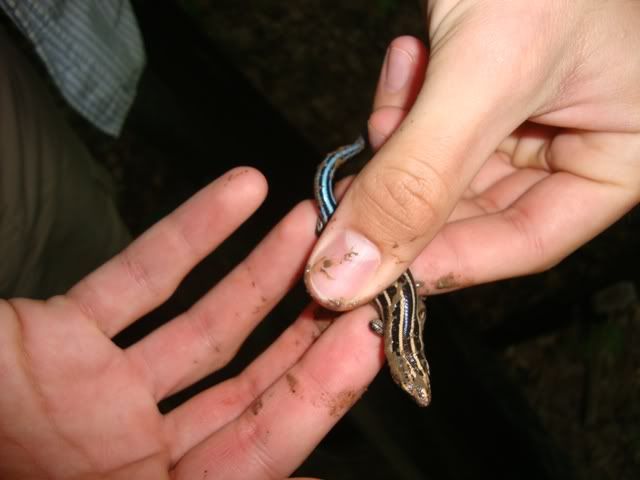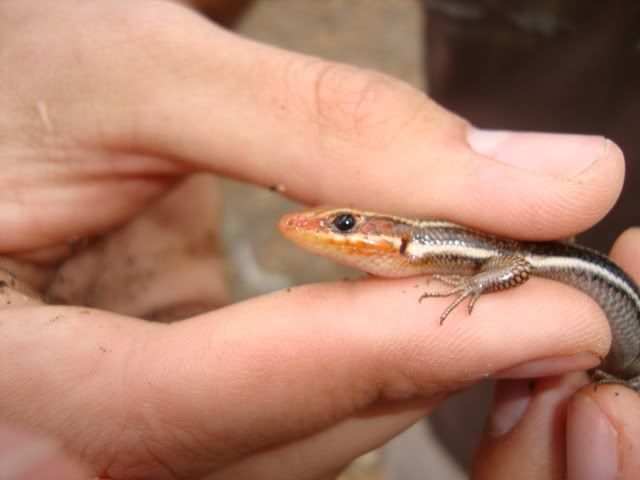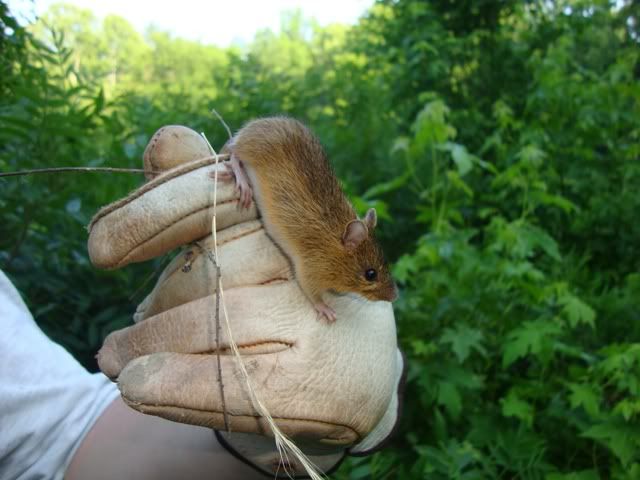Things were hot, muggy and active in the woods this week. Surprisingly, the turtle traps resulted in a big fat goose egg, which was disappointing. There's still time left for turtles to show up, though.
The drift fences, on the other hand, caught some critters to keep us busy!
_________________________________________________________________________
The Eastern Ratsnake (Pantherophis alleghaniensis).
The individual pictured above is a juvenile. As adults, this species mostly loses the pattern found in juveniles. In fact, I've posted some pictures not long ago where you can sort of see what this species looks like as an adult (see The Snake Hole posted on April 22, 2011). They are basically black on the top (or dorsal) surface as adults. We caught him in a funnel trap along one of our lowland forest drift fences. After recording the appropriate morphological data, I let him go on a low-growing tree branch nearby. Within 40 seconds he climbed to an adjacent tree with no lateral branches and scaled it, up to 40 feet (just by gaining purchase on the tree's bark somehow). Then we lost sight of him.
The taxonomy of this group of snakes (i.e., the ratsnakes) has been somewhat in flux over the last 10 years. For decades, ratsnakes were considered members of the genus Elaphe. At that time, the Eastern Ratsnake was part of a group that was sort of generically referred to as the Black Ratsnakes (Elaphe obsoleta), with various sub-specific designations depending on location. Around 2002, new analyses revealed that the genus name of the New World Ratsnakes (those in North America and South America) should be changed to Pantherophis (Utinger 2002). While this change took awhile to catch on, it is now...basically...accepted by most professional herpetologists. Other taxonomic research (focused mostly on mitochondrial DNA and physical characters) resulted in the elimination of all subspecies for this genus. Instead of having a variety of subspecies of Pantherophis obsoleta, three distinct species were classified based on region: the Eastern Ratsnake (P. alleghaniensis) in the east, the Gray Ratsnakes (P. spiloides) in the midwest, and the Texas Ratsnake (P. obsoletus) in the west (Burbrink et al. 2000, Burbrink 2001). Honestly, there may have been more changes since then. It's hard to keep up with it since the advent of molecular techniques, which can allow for questions of this nature to be investigated much faster than in the days of analyzing hundreds of museum specimens.
___________________________________________________________________________
The Five-Lined Skink (Plestiodon fasciatus). Although this is a Five-lined Skink, there is also the potential for Southeastern Five-lined Skinks (Plestiodon inexpectatus) around here. These two species are pretty hard to distinguish. Basically one can look at the size of the scales on the lower surface of the tail, or count the number of labial (mouth) scales between the eye and the nostril on the side of the head to identify them. I wish I had good pictures of what I'm talking about! Didn't think about it when we were snapping photos of the animal.
These are a fairly common woodland lizard. Relatively small, and usually found rooting through ground debris, and beneath logs for invertebrates....there is a pronounced sexual dimorphism (differerence in how males and females appear) in the breeding season. Adult males have reddish heads and often lack the bright blue tail of the female and juvenile (see reference picture below). The individual we captured (pictured below) was probably an adult female, and we found her in a pitfall trap along one of our lowland deciduous forest drift fences.
Skinks within the genus Plestiodon were not so long ago considered members of the genus Eumeces. But, based on new molecular analyses, their taxonomy has been re-evaluated (see review in Crother 2008).
As a side note, skinks in the Genus Plestiodon are generally referred to as the "Toothy Skinks". I don't know why....but that name always makes me chuckle.
 |
| The above two pictures show the female Five-Lined Skink that we encountered during surveys this week. Note the bright blue tail and lack of reddish color on the head. |
 |
| A picture of a similar species, the Southeastern Five-lined Skink, found elsewhere in the state. This is a male (note the red tinge on the head), and the male Five-lined Skink appears similar. |
____________________________________________________________________________
The Meadow Jumping Mouse (Zapus hudsonius). An apparently rare species in our fine state (which may be the result of no one really looking). Only a handful of records exist (one in the far western part of the state, and a handful of other recrods to our east). Observations and confirmed presence of this species in the central part of the state (where we live) are rare, so it turns out our finding was very valuable! We found him in one of the box traps along a grassland drift fence.
This is an aptly named critter, with the ability to jump or bound up to three feet, according to (Webster et al., 1985). It can be identified by its large feet, wide band of darker pelage (i.e., fur) down the back, and its long distinctly bi-colored tail (dark on top and light on the bottom),
Interestingly, this is apparently the only mouse in our region that actually hibernates (Webster et al. 1985). They also do not store food for the winter, but lay down a layer of fat to sustain them in their torpor and pop back up sometime in March or April (Webster et al. 1985).
For those interested in more pictures of these guys, John Van Niel recently posted a story about capturing some during Sherman Trap surveys on his cool blog, Backyard Beasts.
 |
| Check out the long feet and dark mid-dorsal pelage (i.e. fur) down the center of the back. |
 |
| Note the bi-colored tail of the individual in the picture above. |
The Black Racer (Coluber constrictor) has become the snake species we most commonly encounter at our sites. This individual was captured in a funnel trap placed along one of our grassland drift fences on the same day we found the Meadow Jumper above. We also happen across them while walking through the woods with some frequency. As the name suggests, they are quick! There can't be a moment of hesitation if one hopes to catch an individual randomly encountered while out and about in the woods.
To top it off, they're usually biters. I've been tagged more by racers than any other snake here in the Southeastern US. It doesn't hurt, and barely draws blood.
The individual in the picture below nailed Dave on the hand a few times.
It builds character, if you ask me.
He looks none-the-worse-for-wear after the experience, anyhow!
I've summarized some pertinent ecological information (such as dietary preferences) for Racers in a past post (see A Good Day for Herps posted March 23, 2011).
Literature Cited:
Burbrink, F.T. et al. 2000. Mitochondrial DNA phylogeography of the polytypic North American Rat Snake (Elaphe obsoleta): a critique of the subspecies concept. Evolution 54: 2107-2118.
Burbrink, F.T. 2001. Systematics of the Eastern Ratsnake complex (Elaphe obsoleta). Herpetological Monographs 15:1-53.
Crother, B.I. (ed) 2008. Scientific and Standard English Names of Amphibians and Reptiles North of Mexico. pp 1-84. SSAR Herpetological Circular 37.
Utinger, U. et al. 2002. Molecular systematics and phylogeny of Old and New World ratsnakes, Elaphe auct., and related genera (Reptilia, Squamata, Colubridae). Russian Journal of Herpetology 9:105-124.
Webster et al. 1985. Mammals of the Carolinas, Virginia and Maryland (1st edition). University of North Carolina Press.




Coluber constrictors are quite the biters (now Coluber mormon here). I too have been tagged by them more than any other snake.
ReplyDeleteAnd you're right - it does build character - it gets you over the surprise, so you don't drop 'em when it happens!
Hey RT....
ReplyDeleteColuber mormon is cool. Looks much more like the racers I'm used to from back in WI (which were apparently Blue Racers (C. constrictor foxii), although I've heard them called both blue racers and yellow-bellies and they look like the western yellow bellies...
Wish we had Buttermilk racers here!
Yep! Getting over the shock means you drop fewer and fewer of them, for sure!
Beautiful little ratsnake.
ReplyDeleteI try to remember to pull on gloves before moving our black ratsnakes when I'm working outside.. feisty suckers!
I hate to go all girlie on you, but skinks are adorable.